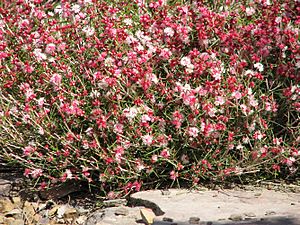White myrtle facts for kids
Quick facts for kids White myrtle |
|
|---|---|
 |
|
| Scientific classification | |
| Genus: |
Hypocalymma
|
| Species: |
angustifolium
|
| Synonyms | |
|
Leptospermum angustifolium Endl. |
|
The white myrtle, also known by its scientific name Hypocalymma angustifolium, is a beautiful type of shrub. A shrub is a woody plant that is smaller than a tree and usually has many stems. This plant belongs to the myrtle family, called Myrtaceae. It grows naturally only in the southwest part of Western Australia. When a plant or animal is found only in one specific place, we say it is endemic to that area.
The Noongar people, who are the traditional owners of the land where this plant grows, call it koodgeed or kudjidi.
What the White Myrtle Looks Like
This lovely shrub can grow up to 1.5 metres (about 5 feet) tall. It has graceful, arching stems and long, narrow leaves.
Its flowers are usually white, but sometimes they can be a mix of white and deep pink. These pretty flowers bloom between June and October in Australia. This time of year is early winter to mid-spring in that part of the world.
A Bit of History
The white myrtle was first officially described by a botanist named Stephan Ladislaus Endlicher in 1837. At that time, he gave it the name Leptospermum angustifolium.
Later, in 1843, another botanist named Johannes Conrad Schauer moved the plant to a different group, or genus, called Hypocalymma. This is why its full scientific name today is Hypocalymma angustifolium.
Growing Your Own White Myrtle
If you like gardening, the white myrtle can be a great plant to grow! It can be shaped into a nice, rounded bush. You can even grow it in a pot or container.
To help it grow well, the white myrtle needs soil that drains water easily. It also prefers a spot that gets some shade, not full sun all day. It's best to protect it from very hot weather and strong winds. This plant can even handle a little bit of frost. Its flowering stems can be cut and used to make beautiful flower arrangements.
For the best growth, give your white myrtle enough water and prune it every year. Pruning helps it grow bushy and full. With good care, a white myrtle can live for many years. After about five years, it might become a dense shrub about 1 metre (3 feet) tall with flexible, weeping branches.

